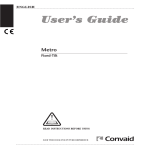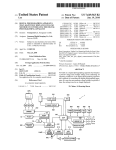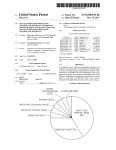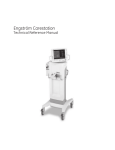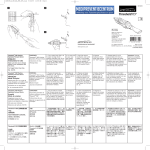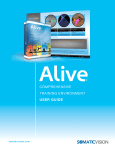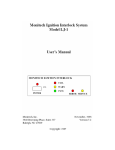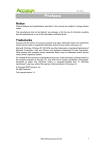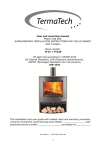Download PowerLung User Guide 0512
Transcript
DISCLAIMER PowerLung products are designed for training and exercise use only. Any other use is not recommended. PowerLung products are not intended to diagnose, treat, cure or prevent any disease. If you have a medical condition, consult your physician before using PowerLung. Consult your physician before beginning this or any training program. WARNING Instructions for use with the above PowerLung ® models. PowerLung products contain small parts that can be harmful to children. Keep PowerLung out of reach of children and do not take PowerLung apart unless instructed to. Includes instructions for cleaning with PowerLung ® Washe™ PowerLung Washe contains harmful materials. Keep out of reach of children. Thank you for choosing PowerLung. Table of Contents Introduction . . . . . . . . . . . . . . . . . . . . . . . . . . . . . . 2 Thank you for your purchase of PowerLung. This document contains everything you need to learn about your PowerLung and how to use it to achieve its benefits. When used as directed, this product provides more than breathing technique. PowerLung is clinically proven to condition and tone the muscles used in breathing. Unlike any other product available today, PowerLung can be used independently to tone, strengthen and condition your breathing muscles. Use PowerLung for all aspects of breathing, breath control and breathing technique for sport, health and performance. The adjustability of PowerLung provides strength while promoting a focus on deep breathing for every aspect of your breathing training and breathing exercises. When you reinforce deep breathing, you get more from any exercise or activity and you reinforce good breathing technique and habits. User Guide Quick Reference Chart . . . . . . . . . . . . . . . . . . . . . . 2 Getting Started. . . . . . . . . . . . . . . . . . . . . . . . . . . . 2 Finding Your Ideal Settings . . . . . . . . . . . . . . . . . . 3 Setting the Inhalation . . . . . . . . . . . . . . . . . . . . . 3 Setting the Exhalation. . . . . . . . . . . . . . . . . . . . . 4 Your Are Ready To Begin . . . . . . . . . . . . . . . . . . . . 4 Warm-Up Program . . . . . . . . . . . . . . . . . . . . . . . 5 Training Program . . . . . . . . . . . . . . . . . . . . . . . . 5 When to Advance In Your Training . . . . . . . . . . . 6 Tips for Success . . . . . . . . . . . . . . . . . . . . . . . . . . . 6 Cleaning . . . . . . . . . . . . . . . . . . . . . . . . . . . . . . . . . 7 1 Introduction Performer Series The purpose of this guide is to train you in the proper way to gain the most benefits from your PowerLung to improve breathing strength training, exercise fitness, resonance and projection, fitness exercises, and overall breathing. Keep in mind that this is a new training program for you. Train hard, practice regularly and enjoy the benefits of PowerLung. Use PowerLung for all aspects of breathing, breath control, and breathing technique. The adjustability of PowerLung provides strength while promoting a focus on deep breathing for every aspect of your breathing training and breathing exercises. When you reinforce deep breathing, you get more from any exercise or activity and you reinforce good breathing technique and habits. The goal of any PowerLung exercise is to: 1. Strengthen, exercise, and condition your breathing muscles. 2. Reduce breathing effort. 3. In crea se b reath in g e ffi ci en cy a nd in crea se endurance. 4. Reinforce deep breathing. Before you begin, please take a moment to review the instructions in this user guide to become better acquainted with your new PowerLung breathing product and program. Quick Reference Chart Inhalation Control Dial Hand Grip Mouthpiece Exhalation Control Dial Lip Shield NOTE: The numbers on the control dials are for reference and to track your progress. Getting Started PowerLung is designed to focus on the core elements of breathing. The Inhalation and Exhalation Control Dials should be set at “1”, the lowest setting. The Inhalation Control Dial and the Ex hal atio n Con tro l Di al adj ust independently and have no effect on each other. During training, you may find your Inhalation Control Dial setting to be different from your Exhalation Control Dial setting. You may also find you do not adjust them at the same time. NOTE: To increase the Control Dial, turn it c loc kwis e. To d e c re a s e t h e Control Dial, turn it counter-clockwise. Active Series and ALIENTO Series Inhalation Control Dial Hand Grip Exhalation Control Dial User Guide Mouthpiece Lip Shield Inhalation Control Dial 1 6 Exhalation Control Dial 1 3 Each Control Dial has a minimum and maximum setting. The Inhalation Control Dial starts at a minimum setting of “1” and can go to a maximum setting of “6”. This Control is used to set the level of effort for breathing in. The Exhalation Control Dial starts at a minimum setting of “1” and can go to a maximum setting of “3”. This Control is used to set the level of effort for breathing out. The size of the opening through which you breathe remains constant regardless of the setting you select. This provides consistency in the flow of air as you make adjustments. Any change in the flow of air is a result of your ability to move air at any given setting. 2 For example, if you increase the setting on one of the Control Dials and notice a reduced flow rate, then that setting is too high for you. Conversely, if you increase the setting on one of the Control Dials and notice relatively little difference in the flow of air or quality of air, then it is time for you to increase the setting (provided the air flow was of a full, robust quality on each breath). WARNING: The Control Dials turn in both directions and can be completely unscrewed if loosened too far. Be careful to avoid this so damage to the PowerLung does not occur. You will notice that the range of settings is almost infinite between the lowest and highest settings. The recommended approach for adjusting the Control Dials is to divide the rotations in relation to one complete turn; for example, one half turn, one quarter turn, one eighth turn, and so on. With experimentation, you gain awareness of the relationship between the various adjustments of the Control Dials. Initially, you may notice little difference when making adjustments on the Control Dial. As you use your PowerLung, you become more sensitive to your choice of settings and increments of adjustment. Remember, less is more. This is most easily accomplished by listening to the sound of the air during breathing. Listen for a full, robust quality to the air during the exercise. Too high of a setting will make it difficult to maintain proper breathing form and achieve a full, deep breath. Finding Your Ideal Settings Everybody is unique. Because of that, everybody’s breathing ability is different. Before beginning any training program with PowerLung, you must determine the ideal settings that are right for you. Do not let pride get in the way of your development by setting the Control Dials too high and making the exercises too difficult. This will do more harm than good. Always keep a good, deep breathing form when using PowerLung. This helps you get more from any activity and reinforces good breathing habits. Remember, the goal of any PowerLung Training Program is to: 1. Strengthen, exercise and condition your breathing muscles. 2. Reduce breathing effort 3. Increase breathing efficiency and increase endurance User Guide 4. Reinforce deep breathing The process for finding your ideal settings is designed to raise your awareness of: 1. How you interact with the different settings; 2. How your body reacts with the different settings; 3. How much is too much? Begin by setting both Control Dials to “1”. This is the least difficult setting. Place the Mouthpiece in your mouth with the Lip Guard outside of your lips as pictured. Breathe in through your PowerLung. Fill your lungs completely in about 3 seconds. Then breathe out completely, pushing all the air out of your lungs in about 3 seconds. Breathe in a relaxed manner and listen for a full, robust sound of air. If the sound is very thin, or light, like breathing through pursed lips, keep your PowerLung set to the least difficult setting. As you become more accustomed to the training, the air should sound more full. When you are able to breathe deeply filling your lungs completely in 3 seconds and generate a full sounding air column, you may begin increasing the breathing effort on the Control Dials. Continue to page 5 to learn how to Wa rm -u p with yo ur PowerLu ng. If you are able to take a full capacity breath and generate a full sounding inhalation and exhalation with the Control Dial set at “1”, you are ready to begin finding your ideal setting within the ranges available. Begin first with the inhalation only. NOTE: Do not bite down on t he M out pi ece. Setting the Inhalation Control Dial To find the proper inhale setting begin by establishing the low and high end of your training or practice range. The low end of your range is the least difficult setting marked as “1” on the Inhalation Control Dial. Breathe out completely, emptying the air in your lungs without the PowerLung. Then, take a deep breath in through your PowerLung. Fill your lungs completely in about 3 seconds. Taking longer than 3 seconds does not give you strength training benefits. Listen carefully for a full, robust sound created by the air moving through the PowerLung. Turn the Inhalation Control Dial one full turn clockwise to increase the setting and repeat the same breathing process. Remember to breathe out completely without the PowerLung before you begin to breathe in. Continue to increase the setting and breathing in pattern until you can no longer fill your lungs completely in 3 seconds, the sound of inhalation is very light, or you feel like you are really working hard but only getting air in the upper part of your 3 lungs. When one of these instances occurs, you have reached the upper end of your inhale range which is too high to give you benefits. Now you have established your training range. Somewhere in the middle is the setting for you. Begin by decreasing the Inhalation Control until you find a setting for you that is about midway between the high end and low end of your range. Since a complete turn represents a significant change in the setting, decrease the Inhalation Control Dial by turning it 1/8 of a turn as you reach the midway point between the low end and high end of your training range. After every adjustment, breathe in. Fill your lungs completely in 3 seconds. Remember to breathe out completely without your PowerLung before breathing in and be sure to use no more than 3 seconds for breathing in. This time you are looking for the ability to breathe to fill your lungs to full capacity, generate a full sounding inhalation with some effort in your breathing. Remember, less is more. Do not let your pride get in the way of good deep breathing. However, do not make it so easy, you do not receive the benefits of exercise and conditioning your breathing muscles. Setting the Exhalation Control Dial Finding this setting is similar to how we found your inhalation setting. The low end of your exhale training or practice is the least difficult setting marked as “1” on the Exhalation Control Dial. This time take a deep breath and fill your lungs completely without the PowerLung. Then breathe out completely in 3 seconds through the PowerLung. Be sure you empty all the air in your lungs in 3 seconds.. Listen carefully for a full, robust sound created by the air moving through the PowerLung. Remember, taking longer than 3 seconds does not give you the strength training benefits. NOTE: Exhaling for PowerLung training is not like any other breathing technique or training you use in sports, music or yoga. This is to strengthen your muscles so you can better and more efficiently perform other breathing techniques. Increase the setting by one full turn on the Exhalation Control Dial by turning it clockwise. Fill your lungs completely without the PowerLung and breathe out completely through it. Continue to increase the setting and exhaling until you can no longer empty your lungs completely in 3 seconds, the sound of exhalation is very light, or you feel like you are really working hard but only getting air in the upper part of your lungs, or you feel pressure in your ears. When one of these instances occurs, you have reached the upper end of User Guide your exhale range. This is too high to give you benefits for the Exhalation Control Dial. Now you have established your training range. Somewhere in the middle is the setting for you. Begin by decreasing the Exhalation Control until you find a setting for you about midway between the high end and low end of your range. Remember, you are looking for the ability to breathe to empty your lungs completely, generate a full sounding in hala ti on wi th some effo rt i n yo ur breathi ng. Congratulations! You have found your ideal settings for the Inhalation Control Dial and Exhalation Control Dial. You are now ready to begin training with your PowerLung. You Are Ready to Begin! There are many ways you can use your PowerLung, whether it is on its own or as an aid with other exercise or training programs. The Warm-Up and Training Program are two programs designed to help you tone and condition your breathing muscles. After you have used the Training Program for at least a month, you can begin to add other routines you design yourself. Here are a few tips before you begin any training with PowerLung. • Never hold your breath during the Training Program. • If you feel lightheaded during training, stop immediately. Let the feeling subside and begin the training again. This is common for new users to PowerLung and usually decreases as you become accustomed to using PowerLung. If it persists, contact your physician. • Do not lift your shoulders when breathing in through your PowerLung. If you find yourself doing it, your Inhalation Control Dial setting may be too high. • When breathing out through your PowerLung, do not puff your cheeks. If you find yourself puffing your cheeks, your Exhalation Control Dial setting may be too high. • If you lift your shoulders when breathing in, or puffing your cheeks when breathing out, try lying down on your back when using PowerLung. Your breathing usually more relaxed this way. • If you lift your shoulders when breathing in, or puffing your cheeks when breathing out, try lying down on your back when using PowerLung. Your breathing usually more relaxed this way. • Make sure to only breathe through your mouth when using PowerLung. Breathing through your nose is not the 4 proper way to train with PowerLung and you will not gain the benefits from PowerLung. If you have difficulty with this, try pinching your nose closed or reducing the settings. • Getting a dry throat is common for new users to PowerLung. If you find yourself getting a dry throat from using PowerLung, take a sip of water between sets to help keep it moist. • Finally, relax and don't think about breathing right. When you have your ideal setting, your body and PowerLung will help you breathe right. Warm-Up Program and fluid your breathing becomes. You achieve a more natural and fluid breath to improve performance, make exercise easier, produce a more resonant and full sound, or improve quality of life. If you do the Warm-Up before the Training Program, make sure you reset the Control Dials to the settings in your journal. The recommended use is 2 sets of 10 breathing repetitions twice each day. Each recommended use period takes about 5 minutes at most. A repetition begins when you breathe in and completely fill your lungs, and ends when you breathe out, completely emptying your lungs. When doing a repetition, you are completing a full range of motion in training your breathing muscles. For the athletes or well-being (Active Series and ALIENTO SERIES), this program can be used just like your stretching or other warm-up activities before any activity, workout, or competition. This gently stretches the muscles and promotes deep, natural breathing. Also use it during long workouts or after any activity, exercise or competition to keep muscles limber, promote muscle relaxation, and reduce blood lactate levels. The steps to performing a repetition are exactly the same as the steps to your ideal settings. This time you combine breathing in and breathing out. For the Performing artist (Performer Series), this program is intended to trigger a natural relaxation response in the body and remind you of the relaxed, natural form you want to reinforce when you produce sound. It can be used throughout the day before playing or singing or to relax during a long practice or a performance. You can also use the M422T model to warm up. • Breathe out through your PowerLung for 3 seconds. Completely empty your lungs at the end. Again, listen for a smooth, full sound of air passing through your PowerLung. When training with PowerLung, it is a good idea to keep track of your settings and progress in a practice journal or training log. Visit www.powerlung.com for more information. 1. If you are not on the minimum setting, turn both Control Dials to decrease to the minimum setting. 2. Exhale all your air before beginning the inhalation then breathe deeply through the PowerLung for 5-10 breaths. 3. Maintain a good, relaxed form with a full range of motion throughout the Warm-Up Program. Training Program The following program is the foundation for any new or returning PowerLung user. This program is designed to strengthen the respiratory muscles. Sports, fitness and wellnessminded individuals reinforce good deep breathing. Developing, serious and professional musicians alike reinforce a smooth, fluid breathing process. Stronger respiratory muscles reduces the perceived effort of breathing and increases your ability to remain relaxed for any activity. The more relaxed your muscles, the more natural User Guide • Breathe in through your PowerLung for 3 seconds. Fill your lungs as completely as possible in this frame. Listen for a smooth, full sound of air passing through your PowerLung. A complete set consists of a total of 10 repetitions. Perform the first 8 as previously discussed. Breathing in from empty to full in 3 seconds then breathing out from full to empty in 3 seconds. When you reach the 9th and 10th repetition, try to breathe in and fill your lungs in 1 second, then breathe out and completely empty your lungs in 1 second. Try your best to maintain a full range of motion, but breathe more quickly for the last 2 repetitions. It is more important to keep the full range of motion than to complete the repetition in 1 second. Do not be discouraged if you cannot do it. Remember that this is a new training program for you and you may not be perfect on the first try. Practice, train hard, and it will become like any other routine in your life. • The recommended daily use of PowerLung is to perform 3 sets of 10 repetitions twice each day. • You can split this between mornings, afternoons, evenings or any routine that works best for you. Be sure to do it at least 2 times a day. • If you cannot do the recommended daily use, do not push yourself. This is a new training program to you and you have never strength trained your breathing muscles. Build yourself up and you will be able to achieve the recommended use with ease. 5 • The recommended use is designed to help those who are beginning with PowerLung. When you become experienced with PowerLung, try building it into other training programs or exercise programs. When to Increase Your Settings The more you do any exercise the easier it becomes. The same is true when you regularly train with PowerLung. With regular PowerLung use you will find it becomes easier to perform either the inhale or the exhale portion of the training program. When it becomes easy either for breathing in or breathing out through your PowerLung, you are ready to advance in your settings. If inhaling is easy, then turn the Inhalation Control clockwise 1/8 of a turn. If exhaling is easy, then turn the Exhalation Control counterclockwise 1/8 of a turn. • Remember that this is a training program.You will not see results unless you keep to it as a routine. • Feel improvements in your breathing in 3 to 5 days. • Train daily with PowerLung for about 3 to 4 weeks and you will start to feel a significant difference in your breathing along with the benefits of increased lung capacity and reduced breathlessness. Remember, you are training muscles. When you stop using PowerLung, the muscles stop training and soon lose all muscle memory of the training. Less is more. This is most easily accomplished by listening to the sound of the air during breathing. Listen for a full, robust quality to the air during the exercise. Too high of a setting will make it difficult to maintain proper breathing form and achieve a full, deep breath. Tips For Success 4. Do not be too caught up in counting. The entire Training Program normally takes 3 to 5 minutes. You will not receive the full benefits of the Training Program if you take longer or do it too quickly. 5. Let your ears be your guide in relation to what settings to use. If you hear a lot of air coming through your PowerLung then you are at a good setting. If it sounds light, like breathing through clenched teeth or pursed lips, it is set too high. 6. As with any exercise, form is important. Do not compromise form in an effort to use a higher setting. Allow common sense and form to dictate the appropriate setting for you. Do not let your pride determine which setting you use. 7. Best results are achieved by using the Training Program twice, daily, as recommended. Otherwise loss of training effect quickly disappears. 8. This is training and should be treated as such. Your settings should be difficult enough to feel some tiredness at the end of each Training Program. You should never be “sore” or feel pain. If you do, stop immediately. 9. Be sensitive to what your body tells you. If you feel lightheaded or dizzy, stop. 10. Like any other training program, if you stop using it you will lose the benefits you gained. The same applies to PowerLung. You will begin to lose the benefits of PowerLung in as little as three days when you stop training with it. Don’t let yourself revert back to the beginning. Use PowerLung daily. 11. Remember to clean your PowerLung regularly with PowerLung Washe, a cleaning solution specifically designed for PowerLung. By not cleaning your PowerLung, residue begins to build up inside, blocking the controls and preventing the proper use of your PowerLung. 1. Each breath should consist of breathing in completely followed by breathing out completely. Work within your full range of motion and use a smooth, fluid breathing process. 2. When referring to a full range of motion, be sure the settings on your PowerLung allow you to breathe in completely in 3 seconds and breathe out completely in 3 seconds. 3. When doing the Training Program, do not use the long, slow breathing cycle you use for playing an instrument, singing, yoga or other breathing techniques. Training with PowerLung gives your breathing muscles the strength and endurance to perform the breath control an d tech ni qu es for th ese o th er acti viti es. User Guide 6 Cleaning WARNING Do not take your PowerLung apart except for the Mouthpiece. PowerLung is NOT microwave or dishwasher safe. Clean your PowerLung product using the specially formulated PowerLung® Washe™ (sample included with your PowerLung). It is important to clean your PowerLung frequently to ensure proper operation. PowerLung Washe can be purchased from any Authorized PowerLung Dealer. Other cleaning products may damage and impair efficiency of your PowerLung. Normal dish soaps may damage the internal components of PowerLung or leave a residue that will affect the performance of the product. Follow the instructions on the PowerLung Washe product to clean your PowerLung product. Use PowerLung Washe to properly maintain your PowerLung product. Remove only the mouthpiece. Place your PowerLung and the mouthpiece in a sink or bowl. Pour approximately ½ ounce of PowerLung Washe into the sink or bowl. Add sufficient hot water to cover the Remove ONLY the entire PowerLung unit. Mouthpiece. Allow the PowerLung unit and mouthpiece to soak in the solution for 15 - 20 minutes. After soaking, remove the PowerLung and mouthpiece from the bowl. Thoroughly rinse both items in warm water. Shake the PowerLung vigorously to remove all excess water. Dry with a clean towel or cloth. Attach the mouthpiece onto the PowerLung. Your PowerLung should now be clean and ready for use. When reattaching the mouthpiece, be sure to slide the mouthpiece into the divot as pictured. You may need to use the tip of your finger to press the mouthpiece into this divot. KEEP PowerLung AND PowerLung Washe OUT OF REACH OF CHILDREN. User Guide 7







